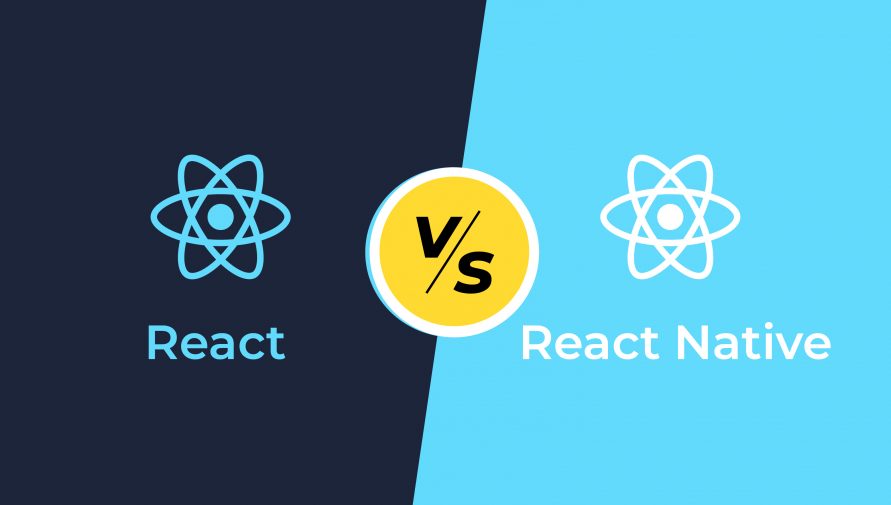Compare and contrast React Native vs React—two popular JavaScript technologies for building user interfaces. Learn how to pick the best one in this guide.
In the ever-evolving world of web and mobile development, two technologies reign supreme: React Native vs React. While their names share a striking similarity, their purposes are distinct. Understanding the differences between React and React Native is crucial for making informed decisions about your next project.
In this article, let’s delve into their core concepts, explore their shared traits, and unveil their contrasting strengths to guide you toward the perfect tool for your needs.
What is React Native vs React?
What is React?

Developed by Facebook, React (also known as ReactJS) is a JavaScript library for building user interfaces. It thrives on the concept of components—reusable building blocks that encapsulate code and functionality. Think of it as Lego bricks for your web app.
With its virtual DOM, React efficiently updates the UI, only rendering changes, making your app lightning-fast and interactive. It shines in creating complex web applications, single-page applications (SPAs), and web portals.
What is React Native?

While React focuses on the web, React Native sets its sights on the mobile realm. It’s a framework for building native mobile applications for both iOS and Android, all with the familiar React syntax.
Instead of manipulating the DOM, React Native leverages native UI components and APIs, ensuring your app looks and feels like it belongs on each platform. This cross-platform development approach enables you to build a single codebase for both Android and iOS, saving time and resources.
Similarities between React and React Native
React and React Native share some common characteristics that make them appealing to developers and users alike. Some of them are:
Open-Source
This affords them a robust and lively community of developers who work tirelessly to update and enhance the software. Additionally, the consistent coding style and documentation make these technologies easy to learn and use.
Use JSX Syntax and React Components
JSX is an extension designed to enable the creation of HTML-like code within the JavaScript programming language. Meanwhile, React components are reusable portions of the user interface that can receive props and state as input and then render them accordingly. This approach is used by both React and React Native to create modular, declarative user interfaces that are simple to maintain and test.
Support Hooks, Custom Hooks, and Functional Components
React has introduced Hooks as a feature, which can be used to incorporate state and other React features without the need to write a class. Additionally, users can also define their own functions—called Custom hooks—to reuse stateful logic across various components.
Instead of defining a class, developers can define functional components as functions. Both React and React Native support this feature, which can help you write code that is simpler and cleaner with less repetition.
Have a Large and Active Community of Developers
React and React Native are highly popular among developers. As a result, they have a thriving ecosystem of libraries, tools, and resources that can expand their functionalities.
React boasts libraries such as Redux, React Router, and Next.js. At the same time, React Native has libraries like Expo, React Native Elements, and React Navigation. These libraries offer immense potential to developers to enhance and extend their applications with ease.
React Native vs React: What Are the Differences?
Despite their similarities, React and React Native also have some crucial differences that make them suitable for different types of projects:
React is a library for web development, while React Native is a framework for cross-platform mobile development.
React is a framework specifically built to develop web applications operating on Internet browsers. On the other hand, React Native is designed to create mobile applications that run natively on iOS and Android devices. This implies that these two frameworks are intended for different platforms requiring separate development environments and deployment methods.
React uses browsers’ DOM to render the UI, while React Native uses native UI components.
React employs a virtual DOM (document object model)—a replica of the actual DOM that gets updated when the state changes. After that, it compares the virtual DOM to the real one and applies the least amount of changes necessary to keep them coordinated.
Conversely, React Native doesn’t utilize the DOM at all. Instead, it uses a bridge to interact with the native platform. It generates the user interface using native UI components provided by the platform or third-party libraries.
React requires additional tools and libraries, while React Native provides most of them out of the box.
React is a library that focuses solely on the view layer of web development. It doesn’t provide any built-in solutions for other aspects like routing, state management, testing, or authentication. Thus, you’ll need additional tools and libraries to complement React to create a full-fledged web application.
On the other hand, React Native is a framework that provides most of these features out of the box. React Native CLI, React Native Debugger, and React Native Testing Library are some of the built-in tools that come with it. You can also choose to use some of the tools and libraries compatible with React—such as Redux and React Router—to further enhance their app-building experience.
React has better performance and compatibility with web standards, while React Native has better portability and accessibility across devices.
React is specifically designed for web development and boasts a faster and smoother performance on browsers than React Native. It’s also better suited to web standards and features like HTML, CSS, and SVG.
In contrast, React Native is optimized for mobile development and offers better portability and accessibility across different devices. With React Native, you can create native mobile applications that have access to the device’s hardware and features, such as the camera, GPS, and accelerometer. Additionally, it enables you to create applications that look and feel native on different platforms like iOS and Android.
React JS vs React Native, Which is Better?

With the similarities and differences laid out, the burning question remains: which framework should you choose for your project? React Native vs React? The answer, as always, depends on your specific needs and goals. Let’s break it down:
Choose React if:
- You’re building a complex web application with dynamic UIs and high interactivity.
- You need SEO-friendly pages for optimal search engine visibility.
- You have a large existing web development team familiar with the React ecosystem.
- You value a vast library of pre-built components and established best practices.
Choose React Native if:
- You want to build native mobile apps for both iOS and Android with a single codebase.
- You prioritize faster development and cost-efficiency compared to native app development.
- You value the familiar React syntax and component-based architecture for mobile development.
- You’re comfortable with potentially slightly lower performance compared to native apps.
Consider a hybrid option if:
- If your project requires both web and mobile functionalities, consider hybrid frameworks like Ionic or Flutter that combine elements of both worlds.
- You can also explore using React Native for your mobile app and integrating a WebView component for specific web-based features.
Final Thoughts about React Native vs React
The choice between React Native vs React isn’t a zero-sum game. Both are powerful tools, each wielding its own strengths in the digital arena. While React reigns supreme for intricate web experiences, React Native unlocks the doors to native mobile development with a familiar key.
Choosing the right tool is like picking the perfect block for your digital edifice. For web-based wonders, React offers a wealth of building materials and established blueprints. However, suppose your vision stretches across mobile platforms. In that case, React Native provides the flexibility and efficiency to craft a seamless experience for both iOS and Android users.
Remember, the ideal framework depends on your project’s blueprint and team’s trowel. So, assess your needs, explore your options, and don’t hesitate to get creative.























